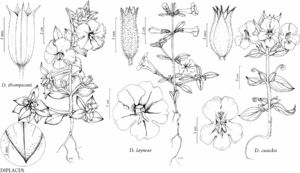Diplacus layneae
Phytoneuron 2012-39: 29. 2012.
Herbs, annual, herbage usually drying dark. Stems erect, 30–160(–300) mm, nodes 3–6, glandular-puberulent to glandular-pubescent, hairs 0.2–0.8 mm. Leaves usually cauline, relatively even-sized; petiole weakly delimited; blade elliptic to narrowly elliptic, oblanceolate, elliptic-oblanceolate, or elliptic-lanceolate, 8–27(–35) × 2–8 mm, margins entire, rarely toothed, plane, apex rounded to obtuse, surfaces: proximals often glabrate, distals glandular-puberulent or glandular-pubescent. Pedicels 2–4(–5) mm in fruit. Flowers 2 per node, or 1 or 2 per node on 1 plant, chasmogamous. Calyces symmetrically attached to pedicels, not inflated in fruit, (5–)6–8(–9) mm, glandular-puberulent to glandular-pubescent, tube strongly plicate, lobes triangular, subequal, apex acute, ribs broad, darkened, blackish, thickened, strongly raised, intercostal areas whitish, membranous. Corollas pinkish or pale to dark magenta or red-purple, each lobe usually with a faint to dark medial line extending 1/2 or less to tip, throat floor yellowish near base, mostly white with red-purple dots near mouth, palate ridges white, tube-throat 10–15 mm, limb (8–)10–16 mm diam., not bilabiate. Anthers included, ciliate. Styles glandular-puberulent. Stigmas included, lobes unequal, abaxial 1.5 times adaxial. Capsules 6–10(–13) mm. 2n = 16.
Phenology: Flowering May–Aug.
Habitat: Road banks, serpentine, granitic sand, red clay, lava beds and volcanic soils, openings in chaparral, shallow dry streambeds or stream banks, burned or otherwise disturbed open areas.
Elevation: (100–)400–2400 m.
Discussion
D. M. Thompson (2005) observed that two forms of Diplacus layneae co-occur from the Yosemite National Park area southward; one of these is recognized here as D. graniticola.
Selected References
None.
